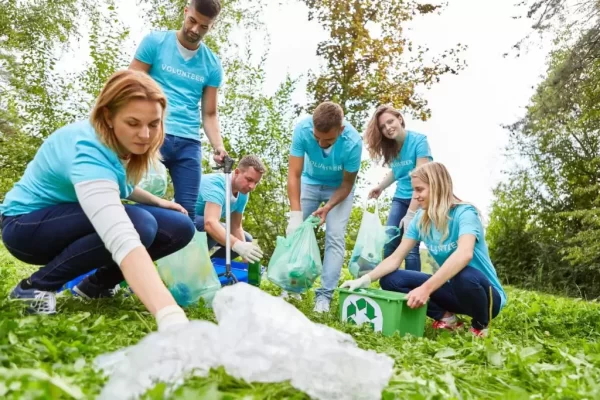Championing Environmental Stewardship: A Comprehensive Guide to Building a Sustainable Future
In the face of growing environmental challenges, the concept of environmental stewardship stands as a beacon of hope and responsibility. As we navigate through the complexities of climate change and resource depletion, embracing stewardship is not merely an option but a crucial imperative. This blog provides an in-depth exploration of environmental stewardship, its profound significance, and actionable strategies for individuals and organizations to foster a more sustainable world.
Understanding Environmental Stewardship:
Environmental stewardship is the active and responsible management of the natural world, aimed at preserving and enhancing the health of our ecosystems and resources. It’s about striking a harmonious balance between human activities and nature, ensuring that our actions today do not compromise the ability of future generations to enjoy a thriving planet. Stewardship encompasses a broad range of practices designed to protect and sustain our environment.
The Vital Importance of Environmental Stewardship:
1. Mitigating Climate Change:
Climate change represents one of the most pressing global issues, primarily driven by human-induced increases in greenhouse gas emissions. Environmental stewardship plays a pivotal role in combating this crisis by promoting strategies that lower carbon emissions. This includes embracing renewable energy sources, advancing energy efficiency, and engaging in carbon offset initiatives. By adopting these measures, we contribute to slowing the pace of global warming and fostering a more stable climate.
2. Safeguarding Natural Resources:
The earth’s resources—such as water, soil, and minerals—are finite and indispensable for sustaining life. Stewardship involves the judicious management of these resources to prevent their overuse and degradation. Practices such as recycling, conserving water, and supporting sustainable agricultural methods help preserve these essential resources, ensuring their availability for future generations and maintaining ecological balance.
3. Preserving Biodiversity:
Biodiversity is the cornerstone of ecological health, yet it faces significant threats from habitat loss, pollution, and climate change. Environmental stewardship includes efforts to protect wildlife habitats, support conservation programs, and address environmental pollutants that harm species and ecosystems. By focusing on biodiversity conservation, we help maintain the intricate web of life that supports all living organisms, including ourselves.
How to Embody Environmental Stewardship:
1. Implement Sustainable Living Practices:
Individuals can make a substantial impact by incorporating sustainable practices into their everyday lives. Simple actions—such as reducing waste, conserving energy, choosing eco-friendly products, and supporting local, sustainable businesses—can collectively contribute to a healthier environment. Each choice made with environmental consideration can lead to meaningful positive changes.
2. Advocate for and Support Green Initiatives:
Organizations and businesses have a crucial role to play in environmental stewardship. By adopting green practices, such as utilizing energy-efficient technologies, minimizing waste through recycling and composting, and developing sustainable supply chains, businesses can significantly reduce their environmental footprint. Additionally, supporting and advocating for policies that prioritize environmental protection can drive broader systemic change.
3. Educate and Raise Awareness:
Education and advocacy are powerful tools for fostering environmental stewardship. By participating in community outreach, environmental campaigns, and educational programs, individuals and organizations can spread the message of responsible environmental management. Advocacy efforts can also influence public policy and inspire others to take meaningful action.

4. Engage in Hands-On Conservation:
Active participation in conservation efforts can make a tangible difference. Volunteering with local environmental organizations, supporting wildlife protection projects, and contributing to habitat restoration initiatives are all effective ways to engage directly in environmental stewardship. These activities help protect and rejuvenate natural habitats, contributing to overall ecological health.
The Future of Environmental Stewardship:
Looking ahead, the role of environmental stewardship will become increasingly crucial as we face escalating environmental challenges. Our commitment to stewardship must be resolute, driving us to adopt innovative solutions and maintain a proactive approach. By fostering a culture of responsibility and action, we can ensure a sustainable future where both people and nature flourish together.
Conclusion:
Environmental stewardship transcends theoretical concepts; it represents a call to action for all individuals and organizations to actively engage in protecting our planet. By understanding its significance and embracing sustainable practices, we contribute to a more resilient and equitable world. Committing to environmental stewardship is a path to a future where the well-being of our planet and its inhabitants are intricately linked, ensuring a thriving and vibrant world for generations to come.
FAQs:
1. What is environmental stewardship, and why is it crucial for our planet?
Environmental stewardship is the proactive management and care of our natural resources and ecosystems with the goal of ensuring their health and sustainability for future generations. It is crucial because it addresses environmental degradation, promotes conservation, and helps us tackle pressing issues like climate change, ultimately ensuring a thriving planet for the long term.
2. How can individuals make a difference through environmental stewardship in their everyday lives?
Individuals can make a significant impact by integrating eco-friendly habits into their routines. This includes reducing waste, conserving energy, recycling, opting for sustainable products, and supporting businesses that prioritize environmental responsibility. Even small, daily actions like conserving water or using public transportation can collectively lead to substantial environmental benefits.
3. What responsibilities do businesses have in the realm of environmental stewardship?
Businesses have a pivotal role in environmental stewardship by adopting sustainable practices such as reducing greenhouse gas emissions, improving energy efficiency, and minimizing waste. Companies can also lead by example through corporate responsibility initiatives, including investing in renewable energy and sustainable supply chains, which can inspire broader industry changes.
4. In what ways does environmental stewardship address climate change?
Environmental stewardship helps combat climate change by advocating for and implementing practices that lower carbon emissions. This includes transitioning to renewable energy sources, enhancing energy efficiency, and participating in carbon offset programs. These efforts are essential for mitigating global warming and achieving climate stability.
5. What are some effective methods for conserving our natural resources?
Effective resource conservation methods involve adopting water-saving measures, improving energy efficiency, and embracing recycling and composting. Supporting sustainable agriculture and making conscious choices about resource use also contribute to preserving these vital resources and ensuring their availability for future generations.
6. How is biodiversity preservation linked to environmental stewardship?
Biodiversity preservation is a fundamental aspect of environmental stewardship. By protecting natural habitats, reducing pollution, and supporting conservation efforts, we help maintain the intricate balance of ecosystems. This biodiversity is essential for ecological stability and resilience, supporting all forms of life and ensuring a healthy environment.
7. What are some hands-on ways to get involved in conservation efforts?
Engaging in conservation can be done through volunteering with environmental organizations, participating in local clean-up events, supporting wildlife protection projects, and contributing to habitat restoration efforts. Direct involvement in these activities helps address environmental issues and promotes the recovery and preservation of natural areas.
8. How do education and advocacy play a role in advancing environmental stewardship?
Education and advocacy are key to advancing environmental stewardship by raising awareness and driving change. Educating communities about sustainable practices, participating in environmental campaigns, and advocating for policy reforms help spread the message of stewardship and mobilize collective action towards a more sustainable future.
9. What is the relationship between environmental stewardship and sustainable development?
Environmental stewardship is integral to sustainable development, which aims to harmonize economic growth with environmental protection and social well-being. Stewardship ensures that development activities are conducted in an environmentally responsible manner, conserving resources and maintaining ecological balance, thus aligning with the principles of sustainability.
10. How can both individuals and organizations maintain their commitment to environmental stewardship?
Maintaining commitment to environmental stewardship involves setting specific goals, regularly assessing progress, and celebrating achievements. Staying connected with environmental communities, continuously learning about new sustainable practices, and recognizing the positive impact of your efforts can also help sustain motivation and drive ongoing engagement.




